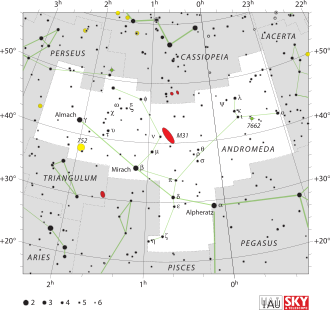41 Andromedae
| Stern 41 Andromedae | |||||||||||||||||||||
|---|---|---|---|---|---|---|---|---|---|---|---|---|---|---|---|---|---|---|---|---|---|
| AladinLite | |||||||||||||||||||||
| Beobachtungsdaten Äquinoktium: J2000.0, Epoche: J2000.0 | |||||||||||||||||||||
| Sternbild | Andromeda | ||||||||||||||||||||
| Rektaszension | 01h 08m 0,85s [1] | ||||||||||||||||||||
| Deklination | +43° 56′ 31,5″ [1] | ||||||||||||||||||||
| Helligkeiten | |||||||||||||||||||||
| Scheinbare Helligkeit | 5,04 mag [2] | ||||||||||||||||||||
| Spektrum und Indices | |||||||||||||||||||||
| B−V-Farbindex | (+0,109 ± 0,021) [3] | ||||||||||||||||||||
| U−B-Farbindex | +0,14 [2] | ||||||||||||||||||||
| R−I-Index | +0,06 [2] | ||||||||||||||||||||
| Spektralklasse | A3m [4] | ||||||||||||||||||||
| Astrometrie | |||||||||||||||||||||
| Radialgeschwindigkeit | (+9,5 ± 0,7) km/s [5] | ||||||||||||||||||||
| Parallaxe | (16,4320 ± 0,1767) mas [1] | ||||||||||||||||||||
| Entfernung | (198 ± 2) Lj (60,9 ± 0,7) pc [1] | ||||||||||||||||||||
| Visuelle Absolute Helligkeit Mvis | +1,19 mag [3] | ||||||||||||||||||||
| Eigenbewegung [1] | |||||||||||||||||||||
| Rek.-Anteil: | (+159,581 ± 0,361) mas/a | ||||||||||||||||||||
| Dekl.-Anteil: | (−60,487 ± 0,117) mas/a | ||||||||||||||||||||
| Physikalische Eigenschaften | |||||||||||||||||||||
| Masse | 2,27 M☉ [6] | ||||||||||||||||||||
| Radius | (2,41 ± 0,13) R☉ [2] | ||||||||||||||||||||
| Leuchtkraft | |||||||||||||||||||||
| Effektive Temperatur | 8511 K [2] | ||||||||||||||||||||
| Alter | 450 Millionen a [6] | ||||||||||||||||||||
| Andere Bezeichnungen und Katalogeinträge | |||||||||||||||||||||
| |||||||||||||||||||||
41 Andromedae (kurz 41 And) ist ein mit dem bloßen Auge gerade noch wahrnehmbarer Stern im nördlichen Sternbild Andromeda. Seine scheinbare Helligkeit beträgt 5,04m.[2] Nach Parallaxen-Messungen der Raumsonde Gaia ist er etwa 198 Lichtjahre von der Erde entfernt. Er hat eine relativ hohe Eigenbewegung, aufgrund derer er 0,171 Bogensekunden pro Jahr entlang der Himmelskugel zieht.[1] Außerdem entfernt er sich mit einer Radialgeschwindigkeit von 9,5 km/s von der Erde.[5]
41 And ist ein Einzelstern, hat also keinen stellaren Begleiter.[7] Er gehört der Spektralklasse A3m an,[4] wobei das Suffix „m“ auf starke Metall-Linien im Spektrum des Sterns hinweist. 41 And besitzt etwa 2,27 Sonnenmassen,[6] 2,4 Sonnendurchmesser (wie sich aus seinem ungefähren Winkeldurchmesser von 0,37 ± 0,02 Millibogensekunden ergibt[2]) sowie 29 Sonnenleuchtkräfte.[3] Seine Oberfläche ist mit einer effektiven Temperatur seiner Photosphäre von circa 8510 Kelvin deutlich heißer jene der Sonne.[2] Mit einer projizierten Rotationsgeschwindigkeit von 84 km/s dreht er sich um seine eigene Achse.[8] Sein Alter wird auf rund 450 Millionen Jahre geschätzt.[6]
Weblinks
- 41 And. In: SIMBAD. Centre de Données astronomiques de Strasbourg, abgerufen am 27. August 2022.
Anmerkungen
- ↑ a b c d e Gaia data release 3 (Gaia DR3) für 41 And, Juni 2022.
- ↑ a b c d e f g h Ellyn K. Baines, J. Thomas Armstrong, Henrique R. Schmitt, R. T. Zavala, James A. Benson, Donald J. Hutter, Christopher Tycner, Gerard T. van Belle: Fundamental Parameters of 87 Stars from the Navy Precision Optical Interferometer. In: The Astronomical Journal. 155, Nr. 1, Januar 2018, S. 16. arxiv:1712.08109. 30. bibcode:2018AJ....155...30B. doi:10.3847/1538-3881/aa9d8b. (Datensatz auf VizieR).
- ↑ a b c d E. Anderson, Ch. Francis: XHIP: An extended hipparcos compilation. In: Astronomy Letters. 38, Nr. 5, Mai 2012, S. 331–346. arxiv:1108.4971. bibcode:2012AstL...38..331A. doi:10.1134/S1063773712050015. (Datensatz auf VizieR).
- ↑ a b Eintrag für 41 And im Bright Star Catalogue, 5. Auflage, 1991.
- ↑ a b G. A. Gontcharov: Pulkovo Compilation of Radial Velocities for 35 495 Hipparcos stars in a common system. In: Astronomy Letters. 32, Nr. 11, November 2006, S. 759–771. arxiv:1606.08053. bibcode:2006AstL...32..759G. doi:10.1134/S1063773706110065. (Datensatz auf VizieR).
- ↑ a b c d R. J. De Rosa et al.: The VAST Survey - III. The multiplicity of A-type stars within 75 pc. In: Monthly Notices of the Royal Astronomical Society. 437, Nr. 2, Januar 2014, S. 1216–1240. arxiv:1311.7141. bibcode:2014MNRAS.437.1216D. doi:10.1093/mnras/stt1932. (Datensatz auf VizieR).
- ↑ P. P. Eggleton, A. A. Tokovinin: A catalogue of multiplicity among bright stellar systems. In: Monthly Notices of the Royal Astronomical Society. 389, Nr. 2, September 2008, S. 869–879. arxiv:0806.2878. bibcode:2008MNRAS.389..869E. doi:10.1111/j.1365-2966.2008.13596.x. (Datensatz auf VizieR).
- ↑ F. Royer, S. Grenier, M.-O. Baylac, A. E. Gómez, J. Zorec: Rotational velocities of A-type stars in the northern hemisphere. II. Measurement of v sin i. In: Astronomy and Astrophysics. 393, Nr. 3, Oktober 2002, S. 897–911. arxiv:astro-ph/0205255. bibcode:2002A&A...393..897R. doi:10.1051/0004-6361:20020943. (Datensatz auf VizieR).
